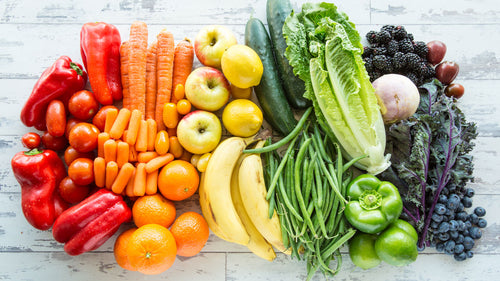
Balancing Your Diet to Prevent Cardiovascular Disease
Published on Wednesday, May 24, 2023 by Piedad CardonaWhen it comes to your health, it is all about balance.
Improperly managing health conditions requiring dietary restrictions can lead to imbalances that can further complicate your health. When you suffer from health conditions requiring a restrictive diet, you must be vigilant and manage the situation, always looking for balance. Foods that must be eliminated must be replaced by foods from the same group and not by another food group.
This article illustrates how when one food group is too heavily incorporated and neglected the “balanced nature” and importance of others, health problems are practically destined. Especially try to avoid compensating by eating more red meat. High consumption of red meat increases the risk of cardiovascular disease, according to the Centers for Disease Control and Prevention.
A Personal Story
My first memory of a hospital, which made me want to become a medical doctor, was at age 10 when my father was hospitalized for several days because of a heart attack. On my first visit, I remember thinking, “One day, I want to work in a place like this.”
Two years later, death visited me when two uncles died after suffering massive and fatal heart attacks. None had even made it to the hospital. Years later, my father was hospitalized again for three coronary bypasses. Yet, six months later, he suffered a cerebral thrombosis, an intestinal thrombosis, and a cerebral hemorrhage, and he died.
After succeeding in my goal to become a doctor, I observed my older brother's triple coronary bypass surgery after he suffered a heart attack. Sometime later, I watched my older sister's surgery due to similar circumstances. In November 2021, at 63, she died from cerebral thrombosis and subsequent cerebral hemorrhage.
The story does not stop here. My mother's life was irreparably changed after her first cerebral thrombosis.
One might think that we inherited all these severe cardiovascular diseases. Yes, they are inherited, but not genetically. They result from family, cultural, and environmental factors. Let me explain this. It is part of something called EXPOSOME.
The Role of Diet
I come from a small town in the Colombian coffee mountains. The last time I visited my family with my husband, he went to the local market to get some groceries and made an interesting observation. Most of the fresh food supply was predominantly beef, chicken, and pork; less than 10% of stores sold fruits and vegetables with minimal variety.
That observation reminded me that while I lived there, we ate beef or pork at breakfast, lunch, and dinner. Our traditional diet includes classic side dishes such as rice, plantains, potatoes, and cassava-- often three of those in the same meal accompanied by beans. Dairy products and fruits were always included in our diet, but salads were generally limited to small portions of cabbage, carrots, beets, onions, and tomatoes.
For generations, the history of cardiovascular disease in the families in the region has been very similar to my family's history. The reason is the limited food supply and solid cultural heritage. This combination of factors condemns people to suffer from these deadly diseases.
This diet looks familiar to many, but an unbalanced diet high in meats, dairy, and carbohydrates and low in vegetables leads to several problems.
High consumption of beef, pork, and dairy products is rich in protein. Considering current “protein-rich” diet trends at face value may sound reasonable. The point is that it is also rich in fat. When we eat a lot of carbohydrates, our body also uses them to make fat.
Normal arteries are elastic and flexible. According to Johns Hopkins Medicine, when fat accumulates in their walls, they become thick and stiff and develop a “cheese-like” development along the artery wall. The buildup of this fat is called plaque.
The plaque causes arteries to narrow and progressively block blood flow. If the arteries that supply the blood with oxygen and nutrients to the heart's walls become clogged, the heart won't be able to beat usually, which will cause cardiac arrest.
Another factor that generates coronary disease, according to the National Institutes of Health, is Trimethylamine N-oxide (TMAO), a dietary byproduct formed by gut bacteria during the digestion of red meat.
In speaking to the thromboses, parts of this fat plaque can break and burst, leading to a blood clot that may travel and plug the artery elsewhere.
Conversely, when we don't consume enough dark green and colored vegetables, we miss out on a protective factor they contain, Nitric Oxide. This substance helps dilate arteries and reduce inflammation when accumulated fat.
The Importance of a Balanced Diet
A balanced diet, including grains, meats, legumes, fats, dairy products, fruits, and vegetables, helps us maintain adequate sources of nutrients that prevent deadly diseases such as cardiovascular disease. According to the World Health Organization, opting for a balanced, adequate, and varied diet is an essential step toward a happy and healthy lifestyle.
Don't let your diet be the cause of your health problems. Take control of your health by balancing your diet and ensuring you get all the nutrients you need to stay healthy.
- World Health Organization. (n.d.). A healthy lifestyle - who recommendations. World Health Organization. https://www.who.int/europe/news-room/fact-sheets/item/a-healthy-lifestyle---who-recommendations
- U.S. Department of Health and Human Services. (2019, January 15). Eating red meat daily triples heart disease-related chemical. National Institutes of Health. https://www.nih.gov/news-events/nih-research-matters/eating-red-meat-daily-triples-heart-disease-related-chemical
- Centers for Disease Control and Prevention. (2022, August 19). Exposome and Exposomics. Centers for Disease Control and Prevention. https://www.cdc.gov/niosh/topics/exposome/default.html
- Thanassoulis, G., & Aziz, H. (2023, April 18). Atherosclerosis - cardiovascular disorders. Merck Manuals Professional Edition. https://www.merckmanuals.com/professional/cardiovascular-disorders/arteriosclerosis/atherosclerosis
- Shen, W., Hintze, T. H., & Wolin, M. S. (1995). Nitric oxide. An important signaling mechanism between vascular endothelium and parenchymal cells in the regulation of oxygen consumption. Circulation, 92(12), 3505–3512. https://doi.org/10.1161/01.cir.92.12.3505
- Centers for Disease Control and Prevention. (2023, March 21). Know your risk for heart disease. Centers for Disease Control and Prevention. https://www.cdc.gov/heartdisease/risk_factors.htm
Leave a comment on this article:
-
Piedad Cardona
Sandra Piedad Cardona, MD

4 Foods & Nutrients That May Improve Your Immune Health

Healthy Salads: Greek Salad Mason Jars
RECIPE INSIDE
Variety Really IS The Spice of Life

Gluten-Free Strawberry Cream Cheese Shortbread Bars
RECIPE INSIDE
Introducing Solid Foods to Babies with Reflux: A Safe and Smooth Journey

7 Reflux-Friendly Snacks With Zero WW Points





